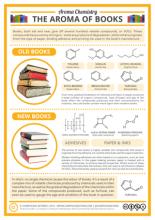Readers all a-twitter over the smell of books

The Research Information twitter account, @researchinfo, has been inundated with visitors after we posted a link to a chart that reveals the chemistry behind the aroma of books.
Perhaps unsurprisingly, with a readership comprising a large number of academic librarians and information professionals, a chart discussing anything to do with books – and a healthy dose of science – the post has gained way more retweets and likes than any other this year.
In brief, the particular smell of new books and magazines is largely dependent on the types of paper, adhesive and ink used in the manufacturing process, while the wide variety of aromas in old tomes – such as almond, vanilla and floral-type smells – is dependent on how old the book is and to what extent it has degraded over the years.
And, for the chemists out there, typical compounds detected in old books include toluene (sweet odour), vanillin (vanilla-like), 2-ethyl hexanol (floral smell), and furfural (almond-like).
The chart was originally created in 2015 by Compound Interest, at CompoundChem.com, which states: 'Everyone’s familiar with the smell of old books, the weirdly intoxicating scent that haunts libraries and second-hand book stores. Similarly, who doesn’t enjoy riffling through the pages of a newly purchased book and breathing in the crisp aroma of new paper and freshly printed ink?'
We couldn't have said it better!
See the full post at www.compoundchem.com/2014/06/01/newoldbooksmell/






